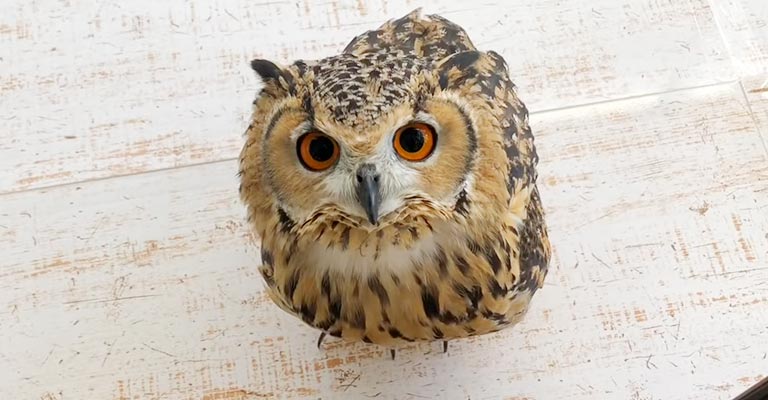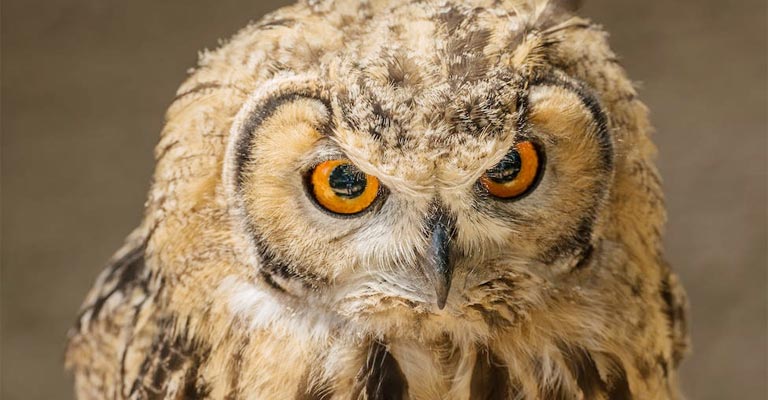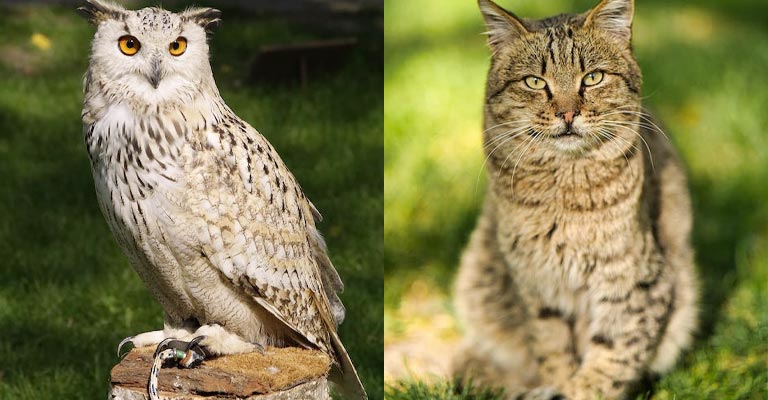The animal kingdom is filled with intriguing adaptations and remarkable mimicry, and one of the most captivating examples of this phenomenon is the visual similarity between owls and cats.
With their large, forward-facing eyes and tufted “ears,” owls often appear strikingly feline in their features. But is this resemblance purely coincidental, or does it serve a purpose in the lives of these enigmatic birds of prey?
In this exploration, we delve into the world of owls to unravel why do owls look like cats.
From the depths of ancient mythology to the intricacies of modern ecology, the convergence of these two seemingly unrelated creatures offers a fascinating glimpse into the forces of evolution and adaptation.
Join us as we uncover the secrets behind this intriguing visual mimicry, revealing the surprising ways in which nature weaves its complex tapestry of life and form.

Why Do Owls Look Like Cats?
The natural world is a tapestry of adaptation, where each creature’s physical form has been honed by the forces of evolution to suit its unique ecological niche.
In this intricate web of life, some striking visual resemblances exist between species, even when they are not closely related. One of the most intriguing examples of this phenomenon is the resemblance between owls and cats.
Nocturnal Lifestyle
Owls and cats have evolved to be primarily active during the night, making them part of the select group of creatures known as nocturnal animals. This shared lifestyle has driven them to develop specialized adaptations for functioning in low-light conditions.
Owls possess large, forward-facing eyes that are adapted for exceptional night vision. These eyes are highly sensitive to even minimal levels of light and allow owls to detect prey in near-total darkness. Cats, too, have eyes equipped for night vision, with a high number of rod cells that are sensitive to dim light.
Predatory Behavior
Both owls and cats are skilled predators. Owls are renowned for their silent flight and remarkable hunting abilities, while cats are known for their stealth and agility in pursuing prey. The visual similarities between the two species serve different purposes related to their predatory behaviors.
The facial discs of owls, often mistaken for “ears,” help funnel sound to their ears and enhance their ability to locate prey by sound alone.
Cats, on the other hand, have tufted ears that can convey their emotional states, offering cues to other animals and potentially serving as a defense mechanism against threats.
Convergent Evolution
The resemblance between owls and cats is an example of convergent evolution, where unrelated species independently evolve similar traits due to similar environmental pressures.
In this case, the selective pressures of a nocturnal lifestyle and hunting in low-light conditions have led both owls and cats to develop features that enhance their effectiveness as predators.
Visual Camouflage
The visual similarities between owls and cats may also play a role in camouflage. Owls’ facial discs can resemble the appearance of a mammal’s face, which might deter potential prey or competitors.
Cats’ tufted ears can give the impression of a larger and more intimidating appearance, particularly in the context of territorial displays.
Mimicry and Communication
Mimicry is not solely about survival and predation. In some instances, it can also be related to communication. Owls’ facial discs, with their central dark “eye” spots, might serve as a form of mimicry or intimidation to deter potential threats.
Similarly, cats’ tufted ears can be used to convey emotions and communicate intentions.
Ecological Roles
Owls and cats occupy distinct ecological niches. Owls are birds of prey that play a crucial role in controlling rodent populations, and helping maintain ecosystem balance.
Cats, especially domestic cats, are often kept as pets and have become part of human lives, serving as companions and pest controllers in households.
Do Owls Have Cat Eyes?

Owls do not have cat eyes, but they do have unique and specialized eyes adapted for their nocturnal lifestyle and hunting behaviors.
The phrase “cat eyes” typically refers to the striking vertical slit pupils seen in cats and some other animals, but owls have distinctly different eye characteristics that suit their specific needs.
Large Eyes
Owls have notably large eyes compared to the size of their heads. These large eyes are one of the most conspicuous features of owls and are adapted for excellent night vision. The size of the owl’s eye allows for a larger retina, which can capture more incoming light.
This adaptation makes it possible for owls to see in very low light conditions and to hunt effectively during the night.
Forward-Facing Eyes
Owls have forward-facing eyes, similar to those of humans and some primates. This arrangement provides them with binocular vision, which means they can perceive depth and accurately judge distances.
Binocular vision is crucial for owls when they swoop down to catch prey, as it helps them precisely gauge the location of their target.
Fixed Eye Sockets
Unlike cats, owls do not have mobile eye sockets. Instead, their eyes are fixed in place, meaning they cannot move their eyes from side to side or up and down.
To compensate for this limitation, owls have evolved highly flexible necks that can rotate up to 270 degrees. This incredible neck flexibility enables them to scan their surroundings without moving their body, and it enhances their hunting efficiency.
Tapetum Lucidum
Owls have a structure in their eyes called the tapetum lucidum, which is also found in the eyes of cats and many other nocturnal animals.
This layer of cells reflects and enhances incoming light, allowing it to pass through the retina twice and increasing the sensitivity of the eye to low levels of light. This is what gives the eyes of owls and cats a characteristic “glow” when exposed to light in the dark.
No Vertical Slit Pupils
One of the key differences between owls and cats is the shape of their pupils. Cats have vertical slit pupils that can change in size to regulate the amount of light entering the eye.
In contrast, owls have circular or oval-shaped pupils. These round pupils are better suited for capturing and processing light in dimly lit environments. The circular shape maximizes the amount of light that enters the eye, helping owls hunt effectively at night.
Highly Sensitive Retina
Owls possess highly sensitive retinas with a high density of rod cells, which are photoreceptor cells responsible for detecting low levels of light. This adaptation allows owls to detect and track prey in near-total darkness.
While cats also have a high rod cell density in their retinas, the unique structure of the owl’s retina further enhances its night vision capabilities.
Would An Owl Pick Up a Cat?

Owls are formidable and skilled predators, but the idea of an owl picking up a domestic cat is generally unlikely.
While it is theoretically possible for an owl to attack and carry off a small cat, such instances are rare and typically involve specific circumstances. Here are some key factors to consider:
Owl Prey Preferences
Owls primarily prey on small mammals, birds, and other animals such as rodents, rabbits, squirrels, and various bird species. Their hunting strategy typically involves ambushing and capturing prey that is within their size range.
Cats, especially adult domestic cats, are generally larger and more formidable than the typical prey of an owl target.
Size Matters
The size of the owl species and the size of the cat play a crucial role in whether an owl would consider a cat as potential prey. Smaller owl species, like screech owls and saw-whet owls, would be less likely to pose a threat to even small domestic cats.
Larger owl species, such as great horned owls and barred owls, are more capable of capturing larger prey, but they still tend to focus on animals that are within a specific size range.
Time of Day
Owls are primarily nocturnal hunters, meaning they are most active during the night. Domestic cats, on the other hand, are often more active during the dawn, dusk, and sometimes during the night.
During these overlapping periods, there is a potential for encounters between owls and cats. However, daytime hunting by owls is much rarer, and most interactions between owls and cats occur during low-light hours.
Urban Environments
In urban and suburban areas, where domestic cats roam freely, there may be an increased likelihood of encounters with owls. Cats that are allowed outdoors can become potential targets for owls due to their visibility and proximity to owl habitats.
To protect cats from potential owl predation, many experts recommend keeping them indoors or providing them with safe outdoor enclosures.
Owls’ Hunting Techniques
Owls are skilled hunters that rely on stealth and surprise to capture prey. They use their keen eyesight and silent flight to approach prey undetected.
Owls typically swoop down from perches to grab prey with their talons. This ambush-style hunting is effective against unsuspecting animals.
Rare Incidents
While it is rare, there have been reported incidents of owls attacking and carrying off small domestic cats. These cases usually involve very small or young cats or owls from large species like great horned owls.
However, such incidents are uncommon and not typical of owl behavior. The majority of owls prefer prey that is more in line with their natural diet.
Protecting Cats
To minimize the risk of potential owl encounters, especially in areas where owls are common, it is advisable to take precautions. Keeping cats indoors during the nighttime hours or providing them with secure outdoor enclosures can help protect them from potential owl predation.
Additionally, ensuring that owls have access to their natural prey can reduce the likelihood of them targeting domestic cats.
FAQs
Why do owls have a cat-like appearance?
Owls often appear cat-like due to their large, forward-facing eyes and facial disk. This adaptation helps them focus on prey with precision in low light, similar to the way cats’ eyes work in the dark.
Do owls and cats share a common ancestor that explains their similar appearance?
No, owls and cats do not share a recent common ancestor. Their similar appearance is a result of convergent evolution, where unrelated species develop similar traits or features in response to similar ecological challenges.
What role does the facial disk play in making owls look like cats?
The facial disk is a flat, circular arrangement of feathers around an owl’s eyes. It helps direct sound waves to the owl’s ears, enhancing their ability to locate prey by sound. While this disk enhances their hearing, its round shape contributes to their cat-like facial appearance.
Are there other cat-like features in owls, besides their eyes and facial disk?
Owls have sharp, curved beaks and talons adapted for capturing and eating prey. These features, along with their silent flight and keen hunting skills, contribute to their overall cat-like hunting prowess.
Do all owl species look like cats?
While many owl species share some cat-like features, there is considerable variation in owl appearance, depending on their size and habitat. Some may have more distinctive features, like “ear” tufts or feathers on their heads, that make them look less cat-like.
Conclusion
The uncanny resemblance between owls and cats is a testament to the wonders of evolution and adaptation in the natural world. While the visual similarities between these two creatures may be intriguing, they have evolved for distinct reasons.
Owls have developed their feline-like appearance as an adaptation for their nocturnal lifestyle and predatory behaviors.
Their large, forward-facing eyes provide excellent low-light vision, and their “ear” tufts play a role in communication and camouflage, contributing to their effectiveness as stealthy hunters.
The convergence of form between owls and cats highlights the fascinating ways in which species adapt to their ecological niches. It also serves as a reminder of the complex web of life, where different species may evolve similar traits in response to shared environmental challenges.
Ultimately, the resemblance between owls and cats is a remarkable example of how nature continually surprises and delights us with its ingenuity and diversity, showcasing the intricacies of life’s remarkable tapestry.